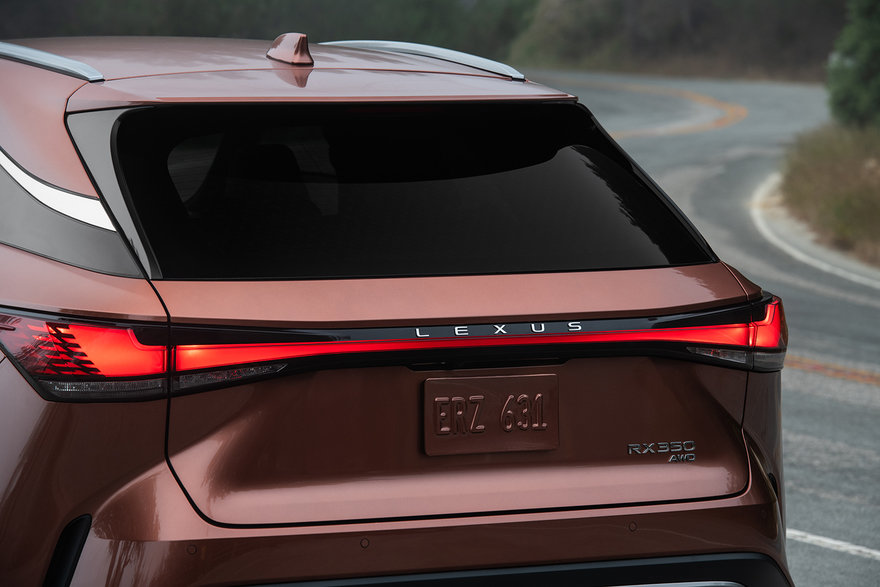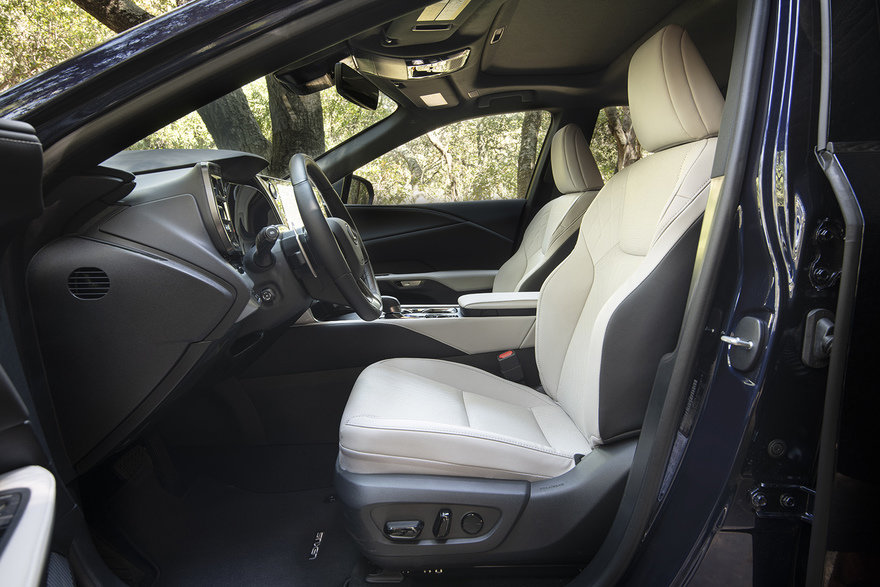An Early Look at the Forthcoming Lexus RX
We drove the pre-production prototypes
It won't be until next month that Lexus starts production on, and launches the ad campaign for, their forthcoming new RX model. But Core77 and a group of mostly automotive journalists was invited to drive and evaluate RX pre-production prototypes, fresh off of the ship from Japan.

The RX is Lexus' mid-size luxury SUV, smaller than the top-of-the-line GX, larger than the crossover NX. The RX was essentially the first luxury mid-size SUV, being introduced in 1998, and has dominated the category since then in terms of sales, at least in the all-important U.S. market.


Notably, sales for the RX have fallen off a cliff in Europe. That continent never had much appetite for SUVs in the first place, and while RX sales there peaked at 14,322 in 2006, they've declined to just 5,347 units sold last year. For comparison's sake, in 2006 Lexus sold 108,348 RXs in America, and last year—even amidst the pandemic and supply shortages--they sold a whopping 115,320.

That tells you two things. One, that this vehicle is not designed to appeal to European tastes, which explains a lot about the look of the vehicle to me. Two, Toyota's incredible, seemingly unbreakable supply chain dominance is one of their many superpowers.
Other superpowers are their reliability—J.D. Power ranked Lexus number one in reliability in 2021—and their engineering.
As for the design, well, let's just say true beauty is on the inside.
The RX, like every vehicle in its class, is saddled with a proportion problem. A mid-size SUV is essentially a box on top of a rectangle, and the sizes required to fit human beings and an engine inside, within the mid-size category, mean that those two shapes don't relate to each other very well. The design teams at different car brands use different techniques to mask this.
The Range Rover Velar's team brilliantly made the top and bottom different colors, acknowledging that they are separate forms and allowing the eye to read a clean beltline as the dominant gesture. But the other brands mostly go off the rails. The BMW X5 grabs hold of your eyeballs with an obscene grille. The Acura MDX tries to fit as many triangles as possible into its surfaces. The Mercedes-Benz GLE adds a very weird lump behind its A-to-C-pillar, as if it's an Audi TT with a hunchback. Only the Volvo XC90 leans into it and goes "Look, I'm an orthopedic shoe, take it or leave it."

Lexus' approach is different—in a nutshell, "Surface it, surface it, surface it." If I had to guess, within Lexus' secretive design studios expressiveness is prized over discipline and the clay modeler's days are long.

One design departure between the new RX and the old, is that the outgoing version's surfaces consisted of hard-edged creases. In contrast, the new design inserts one wildly filleted radius in the swooping gesture that travels from the lower front corner of the front doors up towards the rear doors' handles. Depending on the light and angle, it is visually distinctive but jarring, and I'd like to have seen this executed with more grace.

The car's rear, particularly the transition from the fender to the rear hatch, also reads as discordant, with some extra transitions.


The continuous taillight is cool.

The grille is in line with today's modern SUV design rules: A sheer vertical surface on which to store many repeating shapes.


Where the RX shines—as with all Lexus products—is on the inside. Not just the engineering, which is Toyota-top-notch, but specifically the interior design. It's such a stark contrast that if you showed me the inside first, I would never guess what the outside looks like.



With the exception of a few UX missteps, the interior makes this a car I'd want to drive, every day, if I had a commute. The driver-centric cockpit is comfortable, mostly user-friendly, and feels expensive, with leather and solid-feeling touchpoints. The CMF team has done their job.


The power seats (both heated and cooled are available) seem to have infinite adjustability, making it easy to attain your preferred position, and the steering wheel is also power-adjust, providing precision.

The layout of everything is just about perfect. The massive screen is as high, and thus visible, as it can be without obscuring the road view. Though sandwiched beneath the screen, the central vents can still be made to blow directly on your right hand at 2 or 3 o'clock on the steering wheel.

A "View" button directly beneath the climate knob, and thus easy to find and reach, instantly switches the screen's view (at slow speeds) to the camera setting you have pre-selected. Very handy while parking or trying to squeeze through a narrow space.


The shifter takes a little getting used to, depending on what your daily driver is. Here R, N and D are engaged by the shift knob, but P is a button. I always find that a little discordant, but then I only spent a few hours with the cars.


Fore of the shifter, there's a reasonably spacious storage compartment with a button-activated sliding lid.
The door interior handles have that new Lexus feature where it's button-activated. So you press it with your thumb, the door latch electronically disengages, and then you push the door outwards. I'm still not crazy about this—it seems to me the engineers are still tuning the timing, at least on these pre-production prototypes, between when you hit the button and when the latch disengages—but I do admit it makes the door a bit easier to open.


My main UX gripe is here. The temperature control knob is a physical dial with easy-to-read numbers, which is great. The volume control is a physical knob, silky-smooth, great. But the fan speed control is a touchscreen slider. I hate it. This is virtually impossible to adjust without taking your eyes off of the road.

The nav system is actually quite good. While I'd always prefer using the one in my phone, it's nice to have a solid backup when you're in areas without cell service, which is a reality for me where I live.
The steering wheel is uncluttered and was easy to work out, even in the limited time I had to drive the cars. There are navigation pads on each side that correspond with the left and right screens flanking the central speedometer. The buttons are responsive and, due to their careful placement, easy-to-use without looking at them and without having to stretch your thumbs.



Obviously I was not able to photograph this while driving, but there was a heads-up display in the F-Sport model I drove. It's an awesome feature, and something you want to check for yourself on a test drive. I experimented with several different seating positions during my drive time, and in one of them with the seat bottom down low, I found the HUD drifting out of view if my posture changed. That's probably down to body type.
One note about the interior is that when you drop the rear seats, the load floor is not flat. Then again, this is not a car for picking up flatpack Billy bookcases. It was also not clear, at press time, whether Lexus had jettisoned the optional third row or would offer it on the production models.

When the RX launches later this year, three powertrains will be offered:

The 350 will be available with FWD or AWD, whereas the 350h and 500h are AWD only.
To me, this car only makes sense in its AWD hybrid options, where consumers can get the best of both worlds: A roomy, comfortable vehicle, with better gas mileage than a much smaller car. The fuel-sipper of the RX lineup is the 350h. Its 2.5-liter 4-cylinder gets 36 MPG combined, but offers just decent acceleration; stepping up to the 500h gets you a 2.4-liter turbocharged 4-cylinder, and while the mileage drops to 27 MPG combined, you get more launch off-the-line if you're in a hurry.

Brakes on all models I drove were stellar, with great and confidence-inspiring stopping power, particularly for a vehicle this size. The handling is about what you'd expect from Lexus, with a good balance between ride comfort and the ability to take corners without losing composure.

All in all, this car won't make you forget it's an SUV, but it is reasonably fast, and passing power is available (though requires a bit of patience unless you're driving the 500h). Above all, this vehicle is supremely comfortable.

_________________
I do have to recount one anecdote from the trip, that perhaps only industrial designers would appreciate:
At press events like these, you're not driving the whole time; there's downtime, where you and the other journalists are standing around, waiting for a car or the bathroom, chit-chatting.
The group is typically dominated by dedicated automotive journalists, with a few industry analysts sprinkled in. Design outlets are few, and we're sometimes the only one, meaning I have no one to rant or rave to.
During one break I was chatting with an analyst from a major company. He had never heard of Core77 and asked what I cover. When I said "Design," he said:
"Oh, so you and I are pretty much on opposite ends of the spectrum."
"What do you mean?" I asked.
"I really like function. I'm more of a functionalist. I'm not so into design," he said.
I was stunned. This industry expert regarded design as the opposite of function.
I suppose you could say that's true with some portions of a car's exterior—that a slash across the door doesn't provide any function—but what about the interior? It's amazing to me that this guy doesn't realize that a team of designers are the ones who provide the means to control, well, every function in the car.
After all these years, the recognition of design still has a long way to go.
-
o1Favorite This
-
Q1Comment
K
{Welcome
Create a Core77 Account
Already have an account? Sign In
By creating a Core77 account you confirm that you accept the Terms of Use
K
Reset Password
Please enter your email and we will send an email to reset your password.

Comments
I stumbled upon this article in my news feed, and found your views and opinions to be refreshing, helpful, and thorough. A long-time car magazine subscriber, your article caught things I haven't seen since Robert Cumberford was at Automobile magazine. The writing was clear, and the tech talk wasn't too technical. I've joined the group now, so many interesting articles!